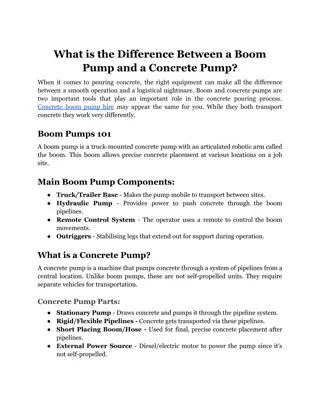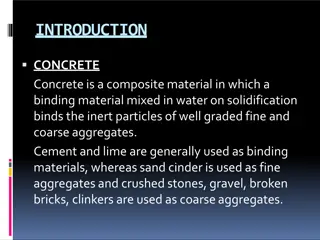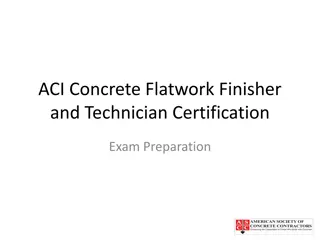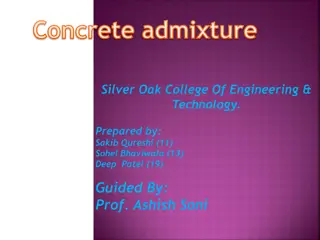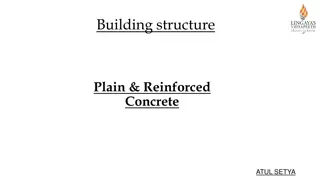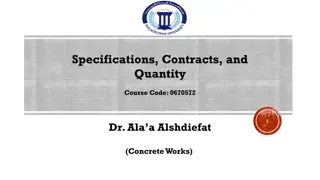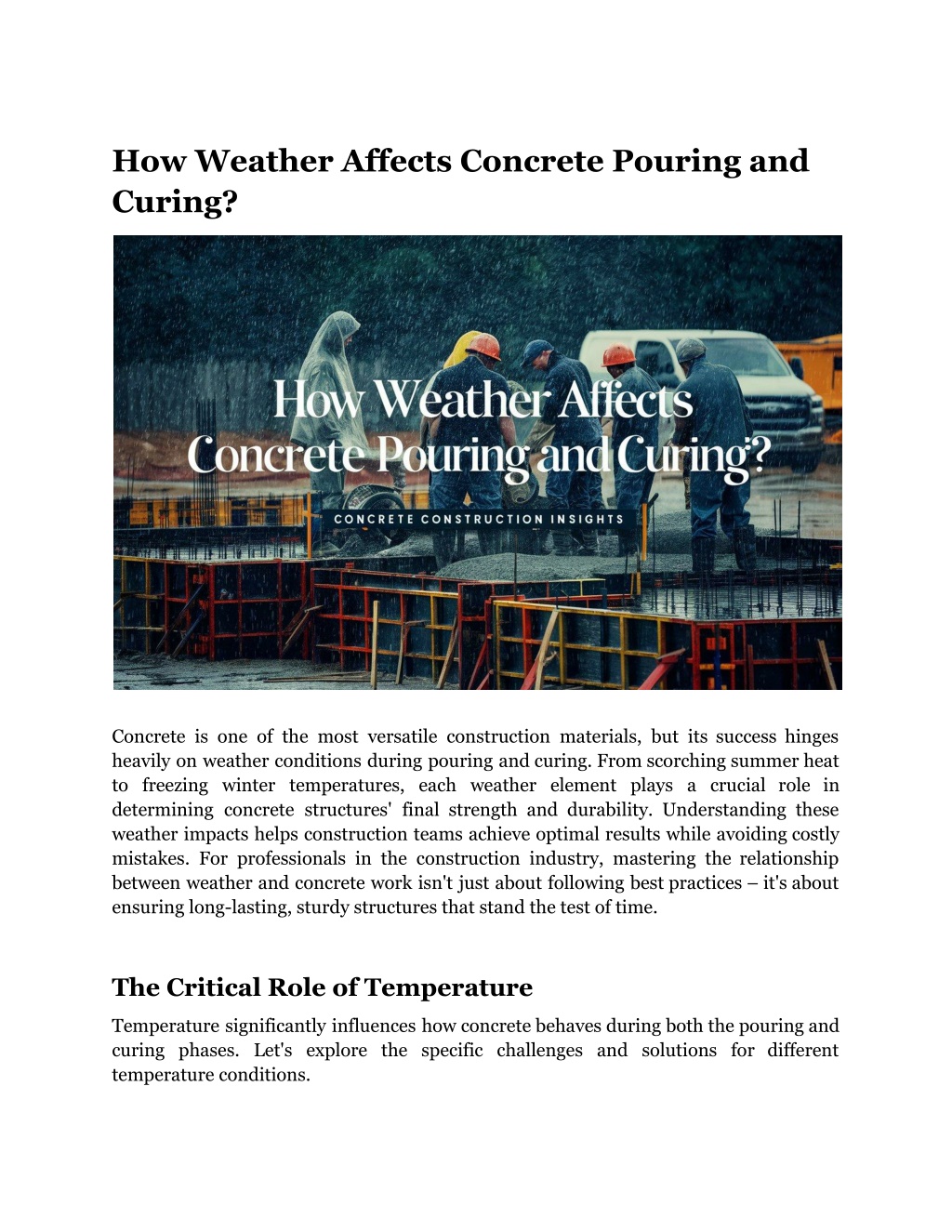
How Weather Affects Concrete Pouring and Curing?
Discover how weather conditions affect the pouring and curing process of concrete, and what precautions to take for the best results.n
Download Presentation

Please find below an Image/Link to download the presentation.
The content on the website is provided AS IS for your information and personal use only. It may not be sold, licensed, or shared on other websites without obtaining consent from the author. Download presentation by click this link. If you encounter any issues during the download, it is possible that the publisher has removed the file from their server.
E N D
Presentation Transcript
How Weather Affects Concrete Pouring and Curing? Concrete is one of the most versatile construction materials, but its success hinges heavily on weather conditions during pouring and curing. From scorching summer heat to freezing winter temperatures, each weather element plays a crucial role in determining concrete structures' final strength and durability. Understanding these weather impacts helps construction teams achieve optimal results while avoiding costly mistakes. For professionals in the construction industry, mastering the relationship between weather and concrete work isn't just about following best practices it's about ensuring long-lasting, sturdy structures that stand the test of time. The Critical Role of Temperature Temperature significantly influences how concrete behaves during both the pouring and curing phases. Let's explore the specific challenges and solutions for different temperature conditions.
Hot Weather Challenges When temperatures soar, concrete faces several challenges that can compromise its integrity: Accelerated water evaporation Rapid setting time Increased risk of surface cracking Reduced workability Potential strength reduction Optimal Pour Timing Smart contractors plan their pours during cooler parts of the day to minimise these issues. Early morning or evening hours provide better conditions for successful concrete placement. Supplier Coordination and Mix Design Working with quality ready mix suppliers becomes particularly valuable during hot weather, as they can adjust mix designs to accommodate high temperatures and maintain workability longer. Getting the timing right requires careful coordination - the concrete shouldn't arrive too early to sit in the sun, nor too late to rush the finishing process. Cold Weather Solutions Cold weather presents its own set of challenges for concrete work. The hydration process slows significantly when temperatures drop, affecting strength development and setting time. Construction teams must take several precautions: Maintain concrete temperature above 50 F (10 C) during placement Use heated water in the mix Protect freshly placed concrete with insulating blankets Consider using accelerating admixtures Monitor internal concrete temperature regularly The Impact of Humidity Humidity levels play a crucial role in concrete curing, affecting both the rate of water evaporation and overall strength development.
Managing Low Humidity Conditions Low-humidity environments can quickly draw moisture from freshly placed concrete, leading to these potential issues: Surface crusting Plastic shrinkage cracks Uneven setting Finishing difficulties Reduced durability To combat these effects, contractors often employ various moisture retention techniques: 1. Fog misting systems 2. Evaporation retarders 3. Wet burlap coverings 4. Plastic sheeting 5. Proper timing of finishing operations High Humidity Considerations While high humidity generally proves beneficial for concrete curing, it can present certain challenges: Extended setting times Delayed finishing operations Potential surface irregularities Modified bleeding patterns Wind Effects and Protection Strategies Wind poses a significant threat to freshly placed concrete by accelerating surface moisture evaporation. Strong winds can create numerous problems: Uneven setting rates Surface crusting Plastic shrinkage cracking Finishing difficulties Reduced surface durability Construction teams must implement effective wind protection measures:
Protective Measures Setting up proper wind protection involves several key strategies: Installing windbreaks Using evaporation retarders Adjusting placement timing Modifying finishing techniques Implementing proper curing methods Rainfall Considerations Rain can severely impact concrete work, making proper planning and protection essential. When working with ready mix concrete suppliers, scheduling deliveries around weather forecasts becomes crucial for project success. Pre-Pour Planning Before beginning concrete placement: Check detailed weather forecasts Have protection materials ready Prepare contingency plans Coordinate with suppliers Brief all crew members During-Pour Protection If unexpected rain occurs during placement: Cover fresh concrete immediately Avoid working water into the surface Protect tools and equipment Document weather conditions Adjust finishing techniques as needed Seasonal Considerations Each season brings unique challenges for concrete work:
Summer Construction Summer concrete work requires careful attention to: Temperature control measures Moisture retention Working time management Curing procedures Quality control testing Winter Construction Winter concrete placement demands: Temperature monitoring Frost protection Extended curing times Modified mix designs Careful planning Best Practices for Weather Management Managing concrete in variable weather requires strategic planning and careful follow-up to ensure quality. Pre-Pour Planning 1. Monitor Weather: Track forecasts to anticipate temperature and humidity changes. 2. Prepare Resources: Have necessary equipment (e.g., heaters, windbreaks) on-site. 3. Coordinate & Document: Work with suppliers for potential mix adjustments and brief your team on conditions. Record site conditions for reference. During-Pour Management 1. Track Conditions: Monitor concrete and air temperatures. 2. Adjust Techniques: Use windbreaks, adjust curing times, and apply protection as needed. 3. Document Changes: Log any adjustments in response to environmental changes to maintain quality control.
Post-Pour Care 1. Maintain Curing: Protect concrete with methods suited to weather conditions (e.g., misting, shading). 2. Monitor Strength: Conduct tests to ensure proper strength development. 3. Document Curing: Record all curing practices and test results for accountability. Technical Considerations Mix Adjustments: Modify water content, add setting agents, and use specific cement types based on temperature needs. Quality Testing: Test for temperature, strength, and moisture to verify concrete quality. Environmental and Economic Impact Environmental: Adjustments may increase energy use, water consumption, and carbon footprint. Economic: Weather-related changes affect labor, material, equipment costs, and project timelines. Following these best practices helps construction teams manage weather impacts effectively, ensuring a durable and high-quality concrete finish. Conclusion Successfully managing weather effects on concrete requires careful planning, proper execution, and continuous monitoring. By understanding and preparing for various weather conditions, construction teams can achieve optimal results and ensure long-lasting concrete structures. Site Article: How Weather Affects Concrete Pouring and Curing?



